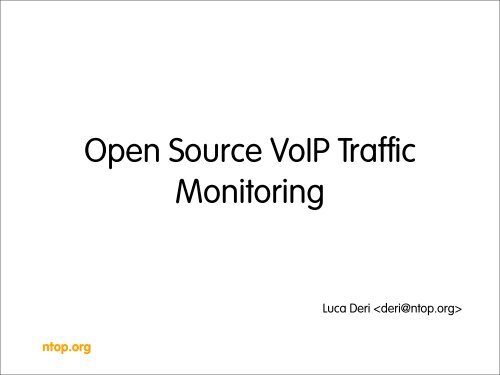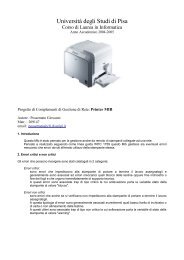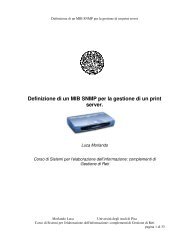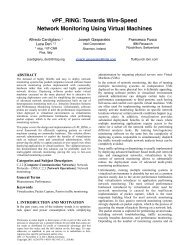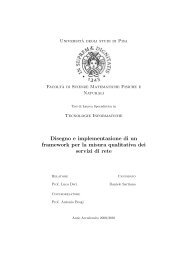Open Source VoIP Traffic Monitoring - Luca Deri - Ntop
Open Source VoIP Traffic Monitoring - Luca Deri - Ntop
Open Source VoIP Traffic Monitoring - Luca Deri - Ntop
You also want an ePaper? Increase the reach of your titles
YUMPU automatically turns print PDFs into web optimized ePapers that Google loves.
ntop.org<br />
<strong>Open</strong> <strong>Source</strong> <strong>VoIP</strong> <strong>Traffic</strong><br />
<strong>Monitoring</strong><br />
<strong>Luca</strong> <strong>Deri</strong>
ntop.org<br />
Why <strong>VoIP</strong> is a Hot Topic ?<br />
• Thanks to open source projects (e.g. Asterisk, Gizmo), and<br />
custom Linux distributions (e.g. Asterisk@Home) setting up a<br />
<strong>VoIP</strong> server is becoming simpler.<br />
• Many modern DSL routers (e.g. Linksys, Fritz!Box) now feature<br />
<strong>VoIP</strong> support via a telephony plug.<br />
• Proprietaries <strong>VoIP</strong> systems like Skype, GoogleTalk or<br />
<strong>VoIP</strong>Stunt! made <strong>VoIP</strong> very simple allowing virtually every PCuser<br />
to take advantage of <strong>VoIP</strong>.<br />
• <strong>VoIP</strong> is currently integrated into many applications (e.g. Office<br />
12) or online assistance/support (e.g. ether.com, estara.com)
ntop.org<br />
Motivation for This Work<br />
• Working groups (e.g http://voip.internet2.edu/, Terena TF-<br />
VVC) are mainly focusing on infrastructure.<br />
• <strong>Traffic</strong> sniffers (e.g. ethereal) are suitable for analyzing<br />
specific calls and not for permanent <strong>VoIP</strong> traffic monitoring.<br />
• <strong>VoIP</strong> servers (e.g. Asterisk) do not offer calls monitoring but<br />
just call info (CDR, call data record).<br />
• Commercial <strong>VoIP</strong> traffic analyzers (e.g. Telchemy VQmon)<br />
are very expensive and are not easy to integrate with other<br />
tools.<br />
• No specific <strong>VoIP</strong> open source traffic analyzer tools available<br />
to date.
ntop.org<br />
Project Goals<br />
• Provide long-term monitoring, contrary to what available<br />
<strong>VoIP</strong> monitoring tools do.<br />
• Handling standard <strong>VoIP</strong> protocols as well, as much as<br />
possible, proprietary protocols.<br />
• Decode calls, hence identify peers (who’s calling who) and<br />
client applications (useful for <strong>VoIP</strong> accounting, billing or<br />
fraud detection).<br />
• Provide <strong>VoIP</strong> metrics such as packet loss and latency, as<br />
well as voice quality.<br />
• Generate traffic trends in order to identify how <strong>VoIP</strong> traffic is<br />
changing over the time (e.g. <strong>VoIP</strong> client/provider usage<br />
statistics).
ntop.org<br />
Approach Being Used<br />
• Enrich ntop, a home-grown open-source passive traffic<br />
monitoring application, for making it <strong>VoIP</strong> traffic aware.<br />
• Define some metrics suitable for monitoring key <strong>VoIP</strong> traffic<br />
characteristics.<br />
• Export <strong>VoIP</strong> measurements via Netflow v9/IPFIX, by means<br />
of nProbe (home-grown GPL NetFlow probe).<br />
• Motivation<br />
– ntop users can also monitor <strong>VoIP</strong> without having to use<br />
any specialized <strong>VoIP</strong> traffic analysis application (<strong>VoIP</strong> is<br />
not a first class citizen).<br />
– The use of NetFlow/IPFIX allows <strong>VoIP</strong> measurements to<br />
be made available to any netflow aware application<br />
(open design).
• Signaling<br />
• User location<br />
• Session<br />
• Setup<br />
• Negotiation<br />
• Modification<br />
• Closing<br />
• Transport<br />
• Encoding, transport, etc.<br />
ntop.org<br />
<strong>VoIP</strong> Basics
Standard <strong>VoIP</strong> Protocols<br />
• SIP<br />
• IETF - 5060/5061 (TLS) - “HTTP-like, all in one”<br />
• Proprietary extensions<br />
• Protocol becoming an architecture<br />
• H.323<br />
• Protocol family<br />
• ASN.1 based<br />
• H.235 (security), Q.931+H.245 (management), CODECs<br />
etc.<br />
• RTP (Real Time Protocol)<br />
• 5004/udp, RTCP: used to transport voice and video<br />
• No QoS/bandwidth management<br />
• Data is encoded using codecs<br />
ntop.org
Proprietary <strong>VoIP</strong> Protocols<br />
• Cisco Skinny<br />
– Signaling protocol, easy to decode and handle.<br />
• Asterix<br />
– IXP (Inter Asterisk eXchange) Protocol: open protocol.<br />
• Skype<br />
– Decentralized architecture (P2P).<br />
– Ability to call both users and plain phones.<br />
– Phone calls are both encrypted and obfuscated.<br />
– Totally closed source development model.<br />
• What to do then?<br />
– Fully support standard <strong>VoIP</strong> protocols.<br />
– Support proprietary protocols as much as possible.<br />
ntop.org
PSTN<br />
ntop.org<br />
Flow-based <strong>Monitoring</strong> Architecture<br />
PC<br />
GW GK<br />
Probe<br />
router<br />
router<br />
GW GK<br />
PC<br />
Institution A<br />
Probe<br />
Probe<br />
Probe<br />
Institution B<br />
Internet<br />
Collector<br />
(ntop)
Standard <strong>VoIP</strong>: Implemented Metrics [1/2]<br />
• SIP<br />
• Unique call identifier used for accounting/billing and tracking<br />
problems as well as correlating protocol messages.<br />
• Call parties: caller and called party.<br />
• Codecs being used (useful for identifying voice quality issues due to<br />
the use of codecs with poor quality).<br />
• Time of important call events such as beginning of the call (e.g. used<br />
to identify performance issues on the SIP gateway).<br />
• RTP ports where the call will take place (used for associating a<br />
signaling flow with the phone call just negotiated).<br />
• RTP<br />
• <strong>Source</strong> identifiers and time-stamp for the first and last RTP flow packet.<br />
• Jitter calculated in both (in to out, and out to in) directions.<br />
• Number of packets lost as well as maximum packet time delta in both<br />
directions.<br />
• Identifier of RTP payload type as specified in [rfc2862].<br />
ntop.org
Standard <strong>VoIP</strong>: Implemented Metrics [2/2]<br />
SIP_CALL_ID<br />
SIP_CALLING_PARTY<br />
SIP_CALLED_PARTY<br />
SIP_RTP_CODECS<br />
SIP_INVITE_TIME<br />
SIP_TRYING_TIME<br />
SIP_RINGING_TIME<br />
SIP_OK_TIME<br />
SIP_ACK_TIME<br />
SIP_RTP_SRC_PORT<br />
SIP_RTP_DST_PORT<br />
ntop.org<br />
SIP Metrics RTP Metrics<br />
RTP_FIRST_SSRC<br />
RTP_FIRST_TS<br />
RTP_LAST_SSRC<br />
RTP_LAST_TS<br />
RTP_IN_JITTER<br />
RTP_OUT_JITTER<br />
RTP_IN_PKT_LOST<br />
RTP_OUT_PKT_LOST<br />
RTP_OUT_PAYLOAD_TYPE<br />
RTP_IN_MAX_DELTA<br />
RTP_OUT_MAX_DELTA<br />
Note: no H.323 support (obsoleted by SIP).
ntop.org<br />
NetFlow <strong>VoIP</strong> Architecture<br />
http(s)<br />
ntop<br />
Web Browser<br />
NetFlow Flows<br />
nProbe<br />
Network <strong>Traffic</strong><br />
nprobe -n 192.168.0.1:2055 -U 257 -T "%LAST_SWITCHED<br />
%FIRST_SWITCHED %IN_BYTES %IN_PKTS %OUT_BYTES %OUT_PKTS<br />
%SIP_CALL_ID%SIP_CALLING_PARTY %SIP_CALLED_PARTY<br />
%SIP_RTP_CODECS %SIP_RTP_SRC_PORT %SIP_RTP_DST_PORT"
ntop.org<br />
ntop <strong>VoIP</strong> Support: SIP/RTP
ntop.org<br />
ntop <strong>VoIP</strong> Support: Skype [1/2]
ntop.org<br />
ntop <strong>VoIP</strong> Support: Skype [2/2]<br />
• Protocol Patterns: http://l7-filter.sourceforge.net<br />
• Pattern Engine: http://www.pcre.org/
ntop.org<br />
<strong>Open</strong> Issues and Future Work<br />
• Skype support is poor (general problem with proprietary<br />
protocols).<br />
• Implement payload analysis (e.g. voice quality).<br />
• Handle RTCP XS (RTP Control Extended) reports sent by<br />
telephony equipment (it contains calls information).<br />
• Implement new metrics such as MOS (Mean Opinion Score)<br />
and R-Factor, used to score traffic calls quality. The drawback<br />
is that most information (e.g. ITU E.411 recommendation) is<br />
proprietary and not freely available in the internet.<br />
• NetFlow/IPFIX are standard protocols but not suitable to carry<br />
CRD (Call Data Records) at least in terms of latency. Solution:<br />
threat CDRs as high-priority flows.
ntop.org<br />
Challenges in <strong>VoIP</strong> Packet Capture<br />
• <strong>VoIP</strong> traffic is usually very little compared to the rest of traffic.<br />
• Capture starts from filtering signaling protocols and then intercepting voice<br />
payload.<br />
• BPF-like filtering is not effective (one filter only)<br />
• It is necessary to add/remove filters on the fly as calls start/end.<br />
• We need to have hundred of active filters (a few per call).<br />
• Solution<br />
– Filter packets directory on the device driver (not into the kernel layer).<br />
– Implement hash/bloom based filtering (limited false positives).<br />
– Memory effective (doesn’t grow as filters are added).<br />
– Currently implemented on Linux on Intel GE cards.<br />
– Great performance (virtually no packet loss at 1 GBit): better than nCap/PF_RING
ntop.org<br />
Dynamic Packet Filtering [1/2]<br />
NAPI<br />
User Space<br />
Linux Kernel<br />
Threading + Bloom Filtering<br />
NIC Device Driver<br />
NIC<br />
Packet<br />
Journey<br />
echo “+ip=192.168.0.10,port=80” > /proc/net/eth1/rules<br />
echo “-proto=tcp” > /proc/net/eth1/rules
ID Intel<br />
Driver<br />
ntop.org<br />
Dynamic Packet Filtering [2/2]<br />
Bloom<br />
Filters<br />
Packet<br />
Size<br />
Total Input Rate<br />
(both adapters)<br />
System<br />
Load<br />
Packet Loss<br />
1 Threaded No filters 900 bytes 270 Kpps 1.14 No<br />
3 Threaded One IP match 900 bytes 270 Kpps 1.66 No<br />
4 Threaded No filters Random<br />
64-1518<br />
5 Vanilla No filters Random<br />
64-1518<br />
6 Threaded One IP match Random<br />
64-1518<br />
890 Kpps 1.34 No<br />
890 Kpps 2.45 Moderate (< 10%)<br />
890 Kpps 1.40 No<br />
7 Threaded No filters 64 bytes 2.89 Mpps 3.68 Moderate ( < 20%;<br />
interface counters do not<br />
keep up with traffic)<br />
8 Threaded One IP match 64 bytes 2.89 Mpps > 4 Strong (> 20%)
ntop.org<br />
Commercial Capture Cards<br />
• Generic Capture Cards (Endace and Napatech/Xyratex)<br />
– Advantages<br />
• Wire speed packet capture (up to 10 Gbit).<br />
• Ability to filter traffic at wire speed.<br />
– Limitations<br />
• The number of filters that can be specified is too small to be usable with <strong>VoIP</strong> (e.g.<br />
Endace allows FPGA-based 7 filters to be specified in the latest 10 Gbit card).<br />
• Filter reconfiguration leads to packet loss as the card is blocked during<br />
reconfiguration (e.g Napatech/Xyratex card can take a few seconds or more).<br />
• Filters are simple packet-offset “data & mask” (i.e. no packet parsing or BPF-like<br />
facilities)<br />
• Specialized Packet Capture Cards (Mutech)<br />
– Ability to operate as an accelerated packet capture card.<br />
– Advanced packet filtering facilities suitable for <strong>VoIP</strong> traffic analysis.<br />
– On-board FPGA-based voice quality analysis.
ntop.org<br />
3Com OSM Router/Switch<br />
There are three Gigabit interfaces and two USB interfaces on the OSM.<br />
Two of the Gigabit interfaces belong to the OSM and the other one<br />
• Ability to specify up to 1024 ASIC-based<br />
complex filters (L2 and port range support).<br />
• Ability to mirror (passive) and redirect (passive+active) traffic.<br />
• Use of dynamic bloom filtering on top of ASIC traffic filtering.<br />
• OSM traffic analysis via nProbe.<br />
protocol between the router and the OSM.<br />
belongs to the router. The router will recognize this interface as another<br />
gigabit interface installed on the router.<br />
Figure 4 Router and OSM System Interaction<br />
Console<br />
Gigabit (eth0)<br />
Router CPU<br />
PCI Bus<br />
Memory<br />
Flash<br />
Serial Port<br />
Gigabit Serial Port<br />
Fiber<br />
10/100/1000<br />
(eth1)<br />
OSM CPU<br />
USB<br />
Memory<br />
Hard Disk<br />
Flash<br />
3Com Router <strong>Open</strong> Services Module
ntop.org<br />
Availability<br />
• Paper and Documentation:<br />
• http://luca.ntop.org/<strong>VoIP</strong>.pdf<br />
• http://luca.ntop.org/Blooms.pdf<br />
• Code and Applications<br />
• http://www.ntop.org/


